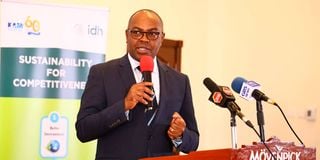Premium
Large factories take steps to ditch costly grid power

Kenya Association of Manufacturers Chief Executive Officer Anthony Mwangi. Manufacturers have blamed costly power for the low competitiveness of Kenyan-made products globally and the relocation of factories to other countries such as Ethiopia, hurting the creation of jobs for skilled youth.
Large factories are increasingly taking the first steps in cutting reliance on costly national grid electricity by gradually investing in small-scale electricity generation plants for internal use.
The firms are continually sinking millions of shillings into mini-grids that largely use solar, while others are exploring investment in wind power plants in the race to transition to green energy operations in the coming years.
Still, some are starting to tap into waste heat — a byproduct of machine operations — to produce their own electricity.
“Our members have started to appreciate that we are stuck with expensive (national grid) power. The question is, is there anything else that can be done? I can tell you that some of the things that are being entertained are the utilisation of what we're calling captive power,” Antony Mwangi, the chief executive of Kenya Association of Manufacturers, told the Nation in an interview.
Manufacturers have over the years blamed costly power for the low competitiveness of Kenyan-made products globally and the relocation of factories to other countries such as Ethiopia, hurting the creation of jobs for skilled youth.
Findings of research by Strathmore University and global business management software firm, Syspro, suggested in July 2019, for instance, that more than half of Kenyan factories operate less than eight hours a day.
About 54 per cent of the 100 manufacturers in the survey cited the cost of energy as a damper to sustaining optimal business operations.
Devki Group, a conglomerate with an interest in cement, steel, and aluminium production, is amongst the companies which have started taking the first steps into generating their own power.
The group says its multi-billion shilling steel smelting plant in Kwale, which started operations last November, does not rely on power supplied by State-run Kenya Power.
“We are also diversifying into power generation by looking at wastage and recovery power in all our factories. The plant is producing its own electricity from the waste heat which is produced by the steel,” billionaire industrialist Narendra Raval, the executive chairman of Devki Group, told the Nation in an interview when the plant when was commissioned.
“We are also putting up a wind power project which will produce 60MW. This will position our group as a green energy company. It will make us more sustainable because energy is the biggest cost in manufacturing.”
Decarbonised manufacturing
The innovation around off-grid power-generation strategies is aligned with Kenya’s plan to gradually switch to decarbonised manufacturing (emissions-free production by switching from fuel-based sources of energy) as part of the ambitious march towards attaining zero carbon emissions by 2050.
This has come on the back of uptake of the costly thermal energy in times of perennial drought, which is prone to volatile prices of diesel and foreign exchange rates.
For example, Kenya Power tapped 166.86-gigawatt hours (Gwh) of power from diesel-run generators in March, contributing the second largest share to the electricity mix to the grid in nearly five years, according to an analysis of data from the Kenya National Bureau of Statistics (KNBS).
Increased supply from thermal plants translates to high bills because the power plants must be compensated for the electricity supplied to the grid even if it is not used.
Conservative estimates showed the thermal plants charge Kenya Power, the near-monopoly state-controlled distributor, as much as $0.20 (Sh27.87 under the average dollar exchange rate of Sh139.35) per unit compared with a wind power rate of $0.08 (Sh11.48) per unit.
Electricity is sold in US dollars, meaning Kenyan households and businesses spend more whenever the shilling depreciates.
“Our power costs are overly expensive on average than other countries that we are competing with. One of the major reasons is the arrangements that the government of Kenya got into a long time ago in terms of thermal or emergency power,” Mr Mwangi said. “There are some companies that are now utilising up to 100 per cent of their captive power. So we think that is going to give a relief to the companies that are able to invest in that. However, it is important but not sufficient because not everybody will be able to develop their own captive power.”
Kenya Power turns to thermal plants to meet demand and ensure stable supply at peak times but low rains that hurt hydro levels further led to increased reliance on dispatch from the thermal plants.
Hydro was for years the single biggest source of electricity in the national power mix until 2015 when it lost out the slot to geothermal due to a combination of poor rains and increased investments in clean energy.
The increased tapping of dirty thermal power hurts Kenya’s plan to transition power generation to 100 per cent clean and affordable sources by 2030.
Some of the firms which have either built or are in the process of putting up solar mini-grids are Kapa Oil Refineries, Williamson Tea Plc, London Distillers, Bamburi Cement, and Pwani Oil.
“From the conversations we have had with line ministries, the government is willing to support those who can generate their own power, especially the big industries, but the smaller ones, still have to rely on the grid,” the KAM chief said. “But there are people operating on solar, others on hydrogen, and perhaps others will operate on biomass.”





